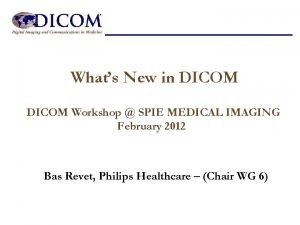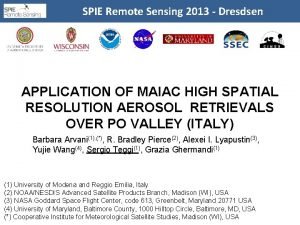Smart cophasing system for segmented mirror telescopes SPIE

- Slides: 1

Smart co-phasing system for segmented mirror telescopes SPIE: 9906 -207 Juan F Simar*a, Yvan Stockmana, Jean Surdejb a. Centre Spatial de Liège, LIEGE Science Park, Avenue du Pré-Aily, 4031 Angleur, Belgium; b. Institut d'Astrophysique et de Géophysique, Université de Liège, Allée du 6 Août 19 c, 4000 Liège, Belgium INTRODUCTION METHODS One of the main challenges in space observations is to observe always fainter and more compact objects. Coarse measurement implementation This can be achieved by increasing the telescope The PSF is measured to calculate the MTF diameters. So, increasing the primary mirror (Modulation Transfer Function). RESULTS Table 1. Results of piston measurements after the co-phasing is finished. Average of 50 measurements (Left column), standard deviation (Central column), HP 55191 A measurement (Right column, this measurement leads to a Standard Deviation of 10 nm). diameters of the telescopes is the challenge solution but it is technically impossible to manufacture monolithic mirrors larger than 10 m in diameter. The use of segmented mirrors thus becomes mandatory. Table 2. Comparison with the Keck telescope system This paper describes the results of a light cophasing setup mounted in laboratory. This setup is able to correct a piston from 200μm to 15 nm based Fig. 2 PSF (left) and MTF (right) used for the coarse measurement on coarse (200μm to 300 nm) and fine (300 nm to 15 nm) measurement methods. Both measurements The peak heights of the MTF are measured are then chained in a feedback system in order to so the distance (200µm to 300 nm) between completely co-phase and keep the segments can be estimated. aligned. Optical Setup CONCLUSIONS Fine measurement implementation The following optical setup has been implemented in order to verify the methods. With the same PSF, the PTF (Phase Transfer Function) is calculated. A very compact and light system has been presented. This system can be adapted to any type of space or ground segmented mirror. The system speed and precision could still be improved using high speed camera and optimized hardware. Compared with Keck, this system has advantages but additional assessment must be performed to validate it for Fig. 3 PSF (left) and PTF (right) used for the fine measurement the case of a real segmented mirror. REFERENCES Fig. 1 Optical setup implementation The heights and inclinations of the PTF peaks are measured so the fine piston It was implemented in a feedback system (300 nm to 15 nm) and tip/tilt between the for automated piston correction. segments can be found. *jfsimar@ulg. ac. be; phone +32 (0)4 382. 46. 00; fax +32 (0)4 367. 56. 13; www. csl. ulg. ac. be 1. Applied Optics, Vol. 54, Issue 5, pp. 1118 -1123 (2015), Single wavelength coarse phasing in segmented telescopes 2. SPIE, vol. 7731, p 165 (2010), First steps of the development of a piston sensor for large aperture space telescopes 3. Proc. SPIE 4003, Optical Design, Materials, Fabrication, and Maintenance, 188 (July 20, 2000), Phasing the primary mirror segments of the Keck telescopes: a comparison of different techniques

